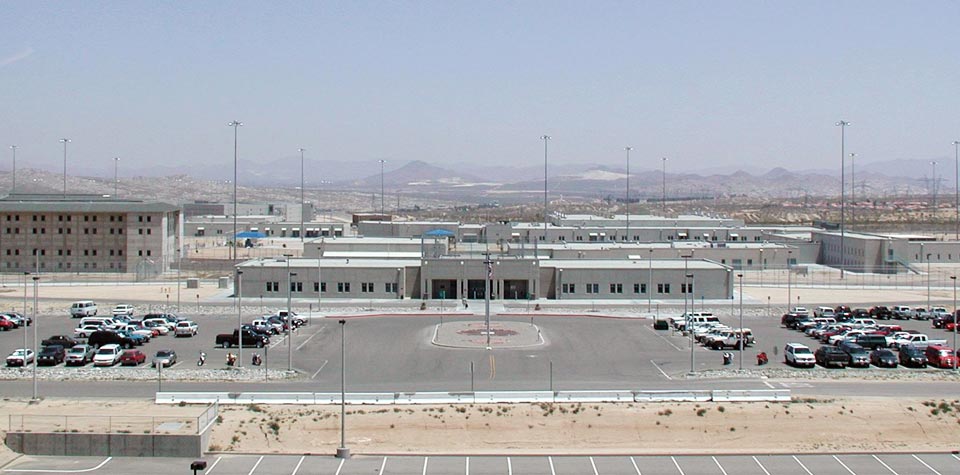
Bureau of Prisons
Earlier this summer, 30-year-old Atinder Paul Singh attempted to enter the United States from India via Mexico. He was headed to the U.S. in search of political asylum because he feared persecution in his home country. His father, Sikh priest Tirath Singh, says that if Atinder Paul would have risked his life by staying in India.
Instead of being reunited with his family, Singh was apprehended by Immigrations and Customs Enforcement (ICE) near Tijuana, Mexico. He was sent to Victorville Medium Security Prison in Southern California, a facility that houses prisoners and civil detainees for the Bureau of Prisons (BOP) and ICE, which is nested under the Department of Homeland Security (DHS). His family did not hear from him until he had been at Victorville for three weeks.
Officials and attorneys told The Los Angeles Times that there has been a recent increase in the number of Indian nationals like Singh attempting to immigrate to the U.S. through Mexico, using travel routes established by Latino immigrants. They continue to represent a small proportion of those detained nationwide.
Singh’s Sikh faith requires that he wear a turban and abstain from eating meat. At Victorville, his turban was confiscated. He was denied replacement head covering. His father, who has lived in California since 2003, explained all of this through a translator.
When they first arrived at the facility, Singh and other detainees were fed lunch meat sandwiches that were sometimes frozen in the middle. No vegetarian alternatives were provided. It didn’t get much better once the mess hall opened to detainees. They were offered two pieces of bread for lunch and green beans and rice for dinner. He lost 15 pounds in less than two months, according to a class-action lawsuit filed in a California district court earlier this month, by the Prison Law Office and the American Civil Liberties Union against President Trump, Homeland Security Secretary Kirstjen Nielsen, and Attorney General Jeff Sessions.
Atinder Paul has since been transferred to another facility, where Tirath says he is waiting to be interviewed by authorities about his asylum application. At Tirath’s temple in California, which used to welcome 60 just-released detainees every week, the numbers have dwindled to 20 or 30. He says he suspects the apparent dip in release rates may be related to the lawsuit.
According to guidelines established by ICE, people housed in its detention centers are required to be served nutritious food three times a day. Meals are supposed to be served in “as unregimented a manner as possible,” meaning detainees have at least 20 minutes to sit and eat. The agency is supposed to accommodate religious and dietary requirements, including kosher and halal options, and the schedules of people who fast for religious reasons.
Indeed, the agency’s Detention Standards manual, published in 2011 and last updated in 2016, seems to indicate that ICE even recognizes mealtimes as a communal activity, a part of the day detainees might look forward to. “The food service program significantly influences morale and attitudes of detainees and staff,” it reads. “And creates a climate for good public relations between the facility and the community.”
But according to this month’s lawsuit, ICE detention facilities are falling far short of the agency’s self-imposed guidelines. People housed at Victorville say they’re fed spoiled meat and milk, rushed out of the dining hall five minutes into their meals, and denied alternative meals requested for religious reasons.
Before the recent crackdown on border crossings, Victorville was never supposed to serve detainees. The prison closed several of its housing units earlier this year due to a staffing shortage and a reduction in inmate population, Mother Jones reports. Guards were floored when the complex agreed to accept 1,000 detainees from ICE. Dozens of prison employees and labor union allies protested the changes outside the facility, carrying signs that read “Budget cuts may result in death.” Advocates worried about detainees mixing with inmates and that the staff shortage would result in inadequate medical care for the whole population—prisoners and detainees alike. The lawsuit says that even before it housed detainees, “Victorville has been recognized as being among the most dangerous places for convicted persons in the BOP’s system of medium security prisons.”
 iStock / Sherry Smith
iStock / Sherry Smith Photographed here is the border wall between San Diego, California and Tijuana, Mexico—near the location at which Atinder Paul Singh was apprehended
“It was a self-made crisis. Pretty much overnight, they had to reopen all of these units and, based on what the head of the prison guards’ union has said, there weren’t additional custody officers hired,” says Corene Kendrick, staff attorney at the Prison Law Office. “So our supposition is that part of the reason why they’re not able to abide by their own standards is because they don’t have enough staff.”
The ICE detainees arrived at Victorville in early June. According to the lawsuit, the facility was just as unprepared for them as staffers had worried it would be. There wasn’t enough medical support to care for the sudden influx of people. The facility went on lockdown during the transition, and Kendrick says detainees claim they were required to wear the same prison uniform every day, and washed their undergarments in the sink and toilet. “It’s just a very chaotic atmosphere,” she says.
~
Anecdotal reports of subpar food at ICE detention centers are not uncommon. In the last two months, CNN has reported on spoiled food served in a privately run facility in Washington, The New York Times published an opinion piece by a former detainee that described spoiled milk served to children, and the Associated Press found that Oregon detainees were being fed meals that violated their religious beliefs. Reports like this predate the Trump administration, though news coverage of the agency has increased since the implementation of the president’s zero-tolerance policy.
Yet advocates argue that caring for ICE detainees under the same conditions as prisoners is unfair. “ICE is the custodial authority, legally,” says Lisa Graybill, deputy legal director for the Southern Poverty Law Center. “It’s not fine to let the standards slip.”
It’s easy to imagine why facilities might try to cut corners when it comes to feeding detainees. In private facilities, where many are housed, ICE contractors could potentially eke out a little extra profit by cutting costs and skimping on food quantity and quality. Even in publicly-run institutions, some districts contract with private food-service providers, where the same profit motives can come into play. In county jails, too, the incentives can be skewed. In Etowah County, Alabama, for example, the sheriff is allowed to pocket leftover money allocated for food. According to Alabama.com, Sheriff Todd Enkin pocketed more than $750,000 over three years from the food fund and bought a beach house with the money in September 2017. (Though, ICE detainees weren’t housed there.)
Yet even under BOP policies, which are even less accommodating, detainees (and inmates) are entitled to be fed a few thousand calories a day, and people who don’t eat meat are supposed to be offered vegetarian alternatives. According to the California lawsuit, the alleged conditions at Victorville violate the rules regardless of which set of standards are being followed.
Most of the time, facilities that house detainees are subject to oversight by DHS. (Kendrick says the agreement that governs Victorville may cede that responsibility to BOP instead.) It’s impossible to believe DHS is unaware of the conditions in its own facilities—two recent reports from its in-house inspectors prove otherwise. A December 2017 report from the department’s Office of the Inspector General shows that agency inspectors visited six facilities and found “spoiled, wilted, and moldy produce” as well as “expired frozen food, including meat.” Just a few months earlier, a separate report out of the same office revealed similar findings at a detention center in California: “Detainees were being served, and reported being regularly served, meat that appeared to be spoiled.”
According to Kendrick, these inspections are basically toothless. The Office of the Inspector General lacks the authority, she says, to enforce its suggestions once reports are issued. When agencies have all the evidence in hand and refuse to make changes, legal advocates try to compel the courts to force improvements. That’s where the Victorville story comes in.
~
News agencies (including us, for obvious reasons) tend to focus on food when reporting on living conditions. Every cable news viewer can relate to images of moldy bologna. Graybill from the Southern Poverty Law Center says food is top of mind for detainees as well—the most common complaints she hears are about spoiled and expired food and small portions.
But in the eyes of the law, spoiled food alone doesn’t make a great case. If you can’t prove past-its-prime ham has caused serious medical conditions like massive, widespread weight loss or facility-wide gastrointestinal infections, it’s difficult to make a case for cruel and unusual punishment.
Still, Graybill says nutrition may take on added legal significance if the government decides to open up family detention centers. During the Bush administration, facilities that housed families imposed strict 15-minute-meal rules and refused to let people take juice boxes out of the dining hall. Trouble is, children don’t adapt as easily as adults to short meals and regimented schedules—especially kids who are at a crucial developmental stage and are more affected by weight loss and malnutrition than adults.
“Food is one of the issues I would be very worried about in addition to medical care and healthcare,” Graybill says of potential detention centers for families. “When you start talking about children, all the vulnerabilities are exaggerated.”
If the lawsuit moves forward, the Prison Law Office may be able to compel Victorville to improve its treatment of detainees. Meanwhile, Tirath Singh is waiting for Atinder Paul to be released.










